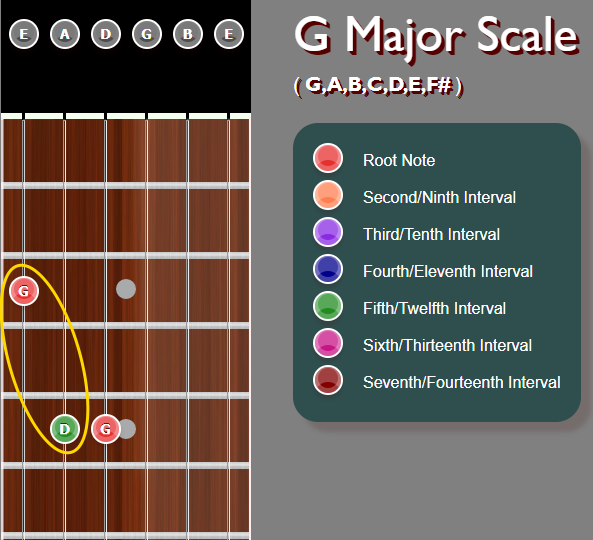Intervals 2
In this tutorial, we go deeper into the intervals in music. Since you're already well versed on intervals in the Major Scale,
this is be fairly easy to understand, and will help you understand harmonic frequencies, and how sounds relate to each other.
Difference Between Chord Intervals and Note Intervals
Intervals are nothing more than the distance between 2 notes. In the Chord breakdown, we were using the Major Scale.
You created chords based on the Major Scale using the Chord Formula. For example, the Major Chord formula is 1-3-5.
This means you take the 1 (root), the 3rd note in the scale (which is a Major 3rd), and the 5th note in the scale (a Perfect 5th).
These 3 notes, make up a Major Chord. It's really simple once you understand it.
Intervals in music are directly related to the harmonic tones of those notes.
Now we will dive into the intervals of all the notes, which is basically the Chormatic Scale.
Intervals Using The Chormatic Scale
In this tutorial, we're going to use the E Chromatic Scale, since the notes on the 1st and 6th string on the guitar are E.
The notes of the E Chromatic Scale are ( E,F,F#,G,G#,A,A#,B,C,C#,D,D# ).
It's nothing more than every note between the root of the scale, and the octave (the E on the 12th fret).
I picked the E Chomatic Scale so that you can simply see the intervals....in the number of the fret it resides on.
For example, the Minor 2nd (m2), is F, which is on the 1st fret. So, the Minor 2nd (m2) is one fret from the root/unison.
Intervals and Their Names
Here is a list of all the notes of the E Chromatic Scale on the fretboard, and their intervals relating to the E Root/Unison

An interval of 5 half steps is a P4 perfect fourth. 3 half steps = m3 minor third
As stated above, a Major Chord is comprised of a 1 (unison/root), Major 3rd (M3), and a Perfect 5th (P5). But we simplify it to 1-3-5
The Minor Chord formula is simply, the 1 (unison), the ninor 3rd (m3), and a Perfect 5th (P5)
Consonance and Dissonance
Consonant intervals are intervals that sound like they belong together. They sound pleasant and sound like they are agreeable with one another
Dissonant intervals are intervals whose sounds seem to cause tension and desire to be resolved to consonant intervals.
Diminished (b5) or Augmented (#5) are considered dissonant intervals, and lead the ear to believe it needs to be resolved.
This is very similar to the Suspended 4th (sus4) chords discussed in a previous tutorial.
Dissonances can be divided into sharp and soft dissonances. Minor second and major seventh are sharp dissonances.
They give the most tension, and have the feeling that the next note/chord will resolve that sound.
The Sounds of the Intervals
Each interval has distinct characterists in relation to the root/unison note.
Characteristics of the Intervals
m2 = High/Sharp Dissonance
M2 = Mild Dissonance
m3 = Soft Consonance
M3 = Soft Consonance
P4 = Consonance or Dissonance
A4/D5 = Neutral or Restless
P5 = Open Consonance
m6 = Soft Consonance
M6 = Soft Consonance
m7 = Mild Dissonance
M7 = High/Sharp Dissonance
P8 = Open Consonance
You can use this information to accent certain notes in your solos, to give a certain feel for the listener to experience.
Why are Perfects called "Perfect"?
Of all the intervals, there are intervals that sound like they go together the best, or are consonant.
These are the unison, which makes sense, since it's the same note as the unison. 2 of the same sound are consonant.
The octave is also consonant, since it's the same note, an octave away.
Another is the 5th, which is considered a "Perfect" 5th.
Since a 4th above a the 5th, creates an inverted 5th, the 4th is also considered "Perfect".
For a recap, here is an example of the 5th and inverted 4th.
Here is a Fifth

Here is the 4th, which is an inverted 5th

Wrap Up
Knowing how notes relate to each other, and how their sounds give the listener a certain feeling can help you write your own music.
It also helps you understand why you have a certain feeling in the music that you listen to. It will help you create those feelings in your own music, and bring out some tension in your songs, and how to resolve that tension.
It will help bring your songs go from boring to help bring your songs to another level.